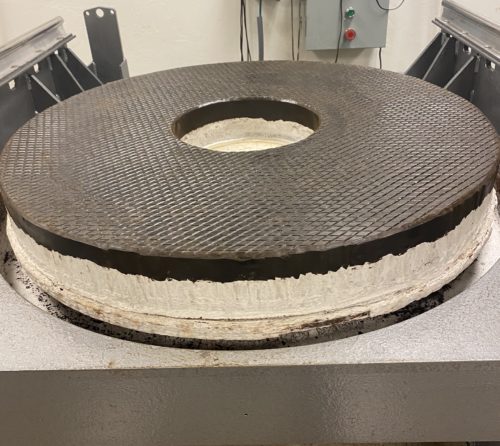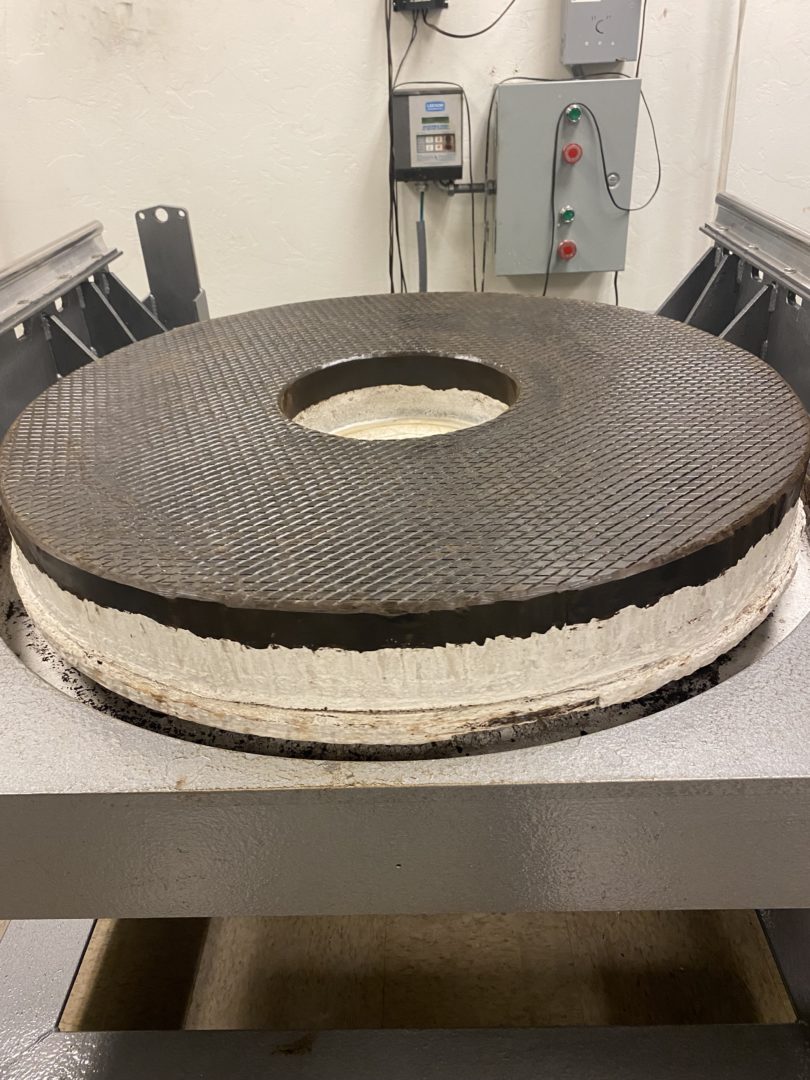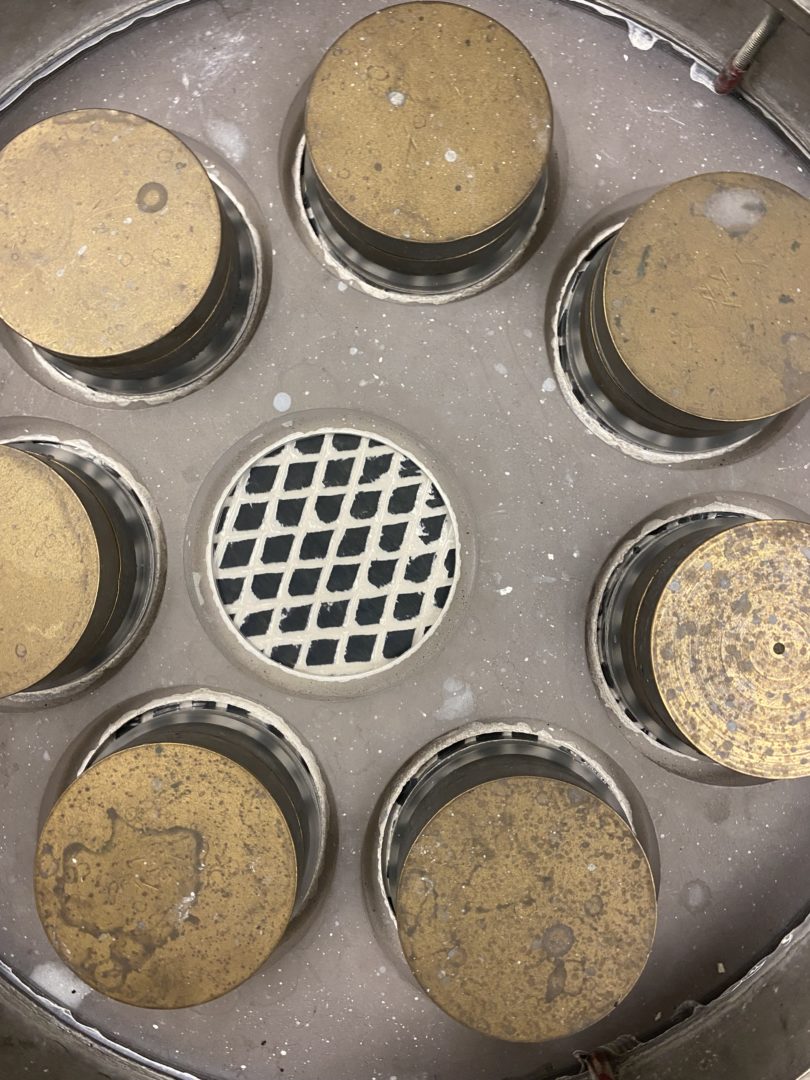
The Lap:
Lunt mixes a proprietary blend of Gugolz pitch for the precision polishing of our Etalon plates via our Continuous Polishing process. The pitch being poured serves as the base for the polishing process. The pitch lap will be scored into a triangular looking pattern using a metal comb by hand.
The lap is actually quite firm but will move/flow at an optical level over a period of about 24 hours, generally going from a few fringes Convex to a few fringes Concave depending on the position of the Counterweight that will be continuously conditioning the lap.
The counterweight is moved to the outer portion of the lap to push the lap Concave, the counterweight is then moved in to to move the lap back to the Convex shape.
The etalon plates will be polished in rotating rings in snug fixtures face down on the lap while a polishing compound is continuously mixed and dripped onto the lap.

The continuous polishing process is a slow process. In general it will take approximately 2 days to finish an etalon surface to the 1/40th wave specification. The back surface of the etalon is polished to better than 1/8th wave. That process takes about a day.
Commercial Processes:
Modern polishing techniques use high speed lapping processes with pads. While these processes are capable of producing a polished surface very quickly, they produce very rough surfaces with a large rolled off area at the edge. Generally speaking these surfaces take on a “bird” shape, concave in the center and convex (rolled) at the edge. The “average” surface profile being quoted at better than 1/4 wave.
Even commercially available 1/20th wave “flats” are only specified over about 80% of the aperture and still exhibit a “bird” shaped profile through the center. The surfaces are polished with the knowledge that several “orders” of error will be removed. These errors often include spherical errors.
Because an Etalon is the combination of 2 flats being placed in very close proximity (0.006″) apart, the error is 2X. Etalons also require that the “feet” that hold the etalon together be placed around the circumference of the plates. Any roll off of the edge would change the gap of the plates and put enormous error into the etalon specification. The “feet” of an etalon need to be kept within a specification of 1/40th wave to maintain performance. The plates from which the “feet” are cut are polished by the same continuous polishing techniques as the etalon plates themselves. In general our etalon plates are specified to 1/40th wave across 99% of the plate diameter.
Lunt Polishing vs Older Techniques:
Older techniques required the use of a center foot that would push or pull the etalon surfaces into parallel. Older techniques also required that the etalon plates be thinner than ideal so that the plates could be pushed and pulled more easily. The use of the center foot and the thinner plates was used to overcome the slight bird shape that would result in speeding up the polishing process to make it more economical.
Lunt’s slow polishing techniques use thicker etalons that provide a stiff structure for the precision surface. Our 24/7 hour process provides the additional time needed to bring the etalon plates to the required specification.
Our etalon plates are tested against each other and not against a test flat. By testing 2 plates from the same batch we will see 2X the error of a single plate. We also use proprietary test techniques that allow us to see errors that a standard interferometer cannot.
Precision:
Lunt has produced some of the world’s most precise “flats” by this method.
An example being a 0.007″ thick Low Expansion Glass wafer, 4″ diameter, with a transmitted wavefront better than 1/120th wave across the entire optical aperture. As tested by BNL.
Wear and Lifespan:

The pitch lap will move and wear over time. The diamond grooves that are cut into the pitch will fill in as the pitch “flows” as the lap is continuously moved from Convex to Concave. The grooves will be continuously re-cut and the edge of the lap trimmed to maintain the polishing rate and precision. This process will wear the lap down and the lap will get thinner. There is a point where the lap is too thin and takes excessive amounts of time to shape. At this point the pitch is removed from the granite backing plate and re-poured. A new lap is poured about every 12 months.
We use a thick (6″) solid granite backing plate to act as a rigid structure for the lap. Granite is used in the manufacture of large precision tables due to its thermal stability and is a good choice for our laps.
Pitch laps are affected by ambient temperature. The warmer the air, the faster the lap moves and vice versa. Our polishing room is double wall insulated and the ambient temperature maintained to +/-1 degree F.
The Magic:
Given that the lap is 36″ in diameter and moved through a few fringes each way, we are able to place smaller etalon plates (1″ – 6″) on the lap to polish. The plate takes on the shape of the lap. However, 1 fringe over 36″ is a small fraction of a wave over the 4″ plate. The key to making the world’s most precise flats is to catch the plates when the 36″ lap passes through the “flat” timeframe when going from Concave to Convex or Convex to Concave. Obviously. It is never quite that simple but the process for the various sizes of plates is predictable given the rate of change of the counterweight and the size of the plates.
It takes several days for a new lap to reach equilibrium. Turning off a lap means that the continuous shaping of the lap via the counterweight has stopped. Lunt run our continuous polishers 24 hours a day, 7 days a week for most of the year. We start the “rough” polishing process overnight and finish the surface figuring process during the day.
The process of pitch polishing is time consuming and labor intensive. However, it results in the highest quality, lowest surface roughness (laser quality), and flattest profile that make up the heart of the Lunt etalon systems.
